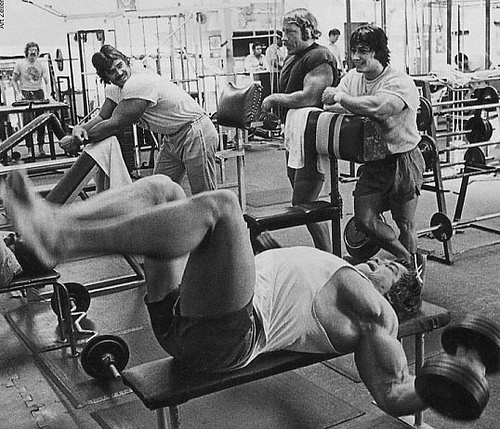Although we have covered German Volume Training rather extensively in our main article on the workout routine, the popularity and high effectiveness of this training regimen brings us back to the topic with an added dose of detail and explanation. Stumbling upon here are probably those who have already heard of GVT and are interested in trying it. For those who have not visited our main article on german volume training, I’m going to offer a quick summary. GVT is a rigorous workout routine that uses high volume and great intensity to really help you pack on size (if your diet is in check, along the way of course!).
The basic premise of GVT is to come in to the gym expecting to do a main exercise for particular body part for 10 sets of 10 reps, and finish off with another lighter exercise for 3 sets of 10 reps. Not only is that well over 100 reps for a particular muscle group, but the workout should be done in a fast-paced manner. That means no sitting around and resting between sets, but getting back into it within 60-90 seconds. German volume training really taxes your system and brings out the animal in you because of its requirement that you sustain a high intensity from beginning to end even as your muscles grow tired after a few sets, forcing you to keep going past your limits. Of course, this is the prime objective of any smart and effective workout routine, because you will not be getting anywhere without Progressive Overload. GVT delivers in that regard, and in many others. However, we’re not going to sit here and explain away why GVT is so effective, we’re here to expand on this topic and cover in more detail what we discussed in our original German Volume Training article. Let’s do this in the form of a Frequently Asked Questions format.
1). German Volume Training results, how much can I really expect to get from this routine?
The inherent flaw with these types of questions is that they presuppose that the results possible with a workout routine can be applied to every individual equally. However, this is far from the case. Every individual will have a different level of success with german volume training, not only based on their intensity (whether they’re really pushing themselves to the limit) but also based on diet. Furthermore, if we make equal the two requirements just mentioned, any two individuals can still have a varying degree of success when it comes to german volume training results because of genetics and a Mind Muscle Connection difference. For some, it is easier to grow their chest muscle than it is to grow another body part like shoulders, and for others its the opposite. In that regard, people will always vary with their workout results. However, a commonly fixable problem deals with their ability to enhance training through the use of a mind muscle connection.
In a flash summary, those who both engage in a shoulder workout but do not mentally control their shoulders in the same manner during an exercise will not achieve the same muscle fatigue for their shoulder group. Person A may just be throwing the weight up, or using excessive tricep help, taking away from their shoulder involvement. The other can block out the use of triceps to the best of their ability, and really push with their shoulders, allowing for maximal fatigue. The article above goes into great detail about this, so check it out. For further insight on how you are in control of how your muscles grow, check out our gaining muscle article as well.
The overall point, therefore, is that the question isn’t whether german volume training produces results, but to what extent you can use german volume training effectively to give yourself results. That is entirely up to you. Keep your diet in check, push yourself with each rep, and the results will come. You’ll be surprised.
2.) German Volume Training, can’t do the last sets?
This is a common issue when it comes to this workout routine. People are required to grab a lighter weight that they can use to complete 10 sets of an exercise, but often times they pick the weight and realize after a few sets that it is lighter than expected. They assume that the rest of the sets will be the same, and usually move up in weight. Once they reach set 7 or 8, they are struggling to finish 10 reps, culminating in failure around the last 2 sets. This is common with german volume training, and a proper way to fix this problem is to lower your weight at the end to make up for your jump earlier. Even if you didn’t jump earlier, lower the weight and finish properly. There’s no reason to stroke your ego with the amount you do, remember, how you do it is the key to success. Focus on your form, and make sure the muscle you are targeting is doing most (if not all) of the work. Trying to push through with a heavier weight because you can’t imagine going down is not going to bring about the most optimal results. It is as much about focus and form as it is about weight, don’t forget that.
3) German Volume Training, is it for size or strength?
The main school of thought would claim that GVT is a size-based routine because of the high volume, whereas strength-based routines focus on low reps and heavy weight. Although this is generally the case, we could write an entire article explaining why the boundary is certainly not black and white as claimed. However, applying it to GVT specifically, the workout routine gives you a nice dose of both. Although the high volume is excellent for size gains, strength is certainly not excluded. As a matter of fact, the two are nowhere near exclusive to each other (and this goes beyond GVT). If you use progressive overload properly, and go up in weight each week (at the very least, a rep or two at the same weight), you will still be gaining strength.
Usually, when we refer to strength gains they deal with the CNS (central nervous system) and its adaptation to the workload you provide it. However, at the end of the day, a rise in numbers is a rise in numbers, and that’s what strength encompasses. Someone who does 40lb dumbbels for chest press on Week 1 of GVT, and moves up to 50s on their last week, has risen in strength considerably in the process. If they had not, this rise would not have occurred. When they return to a different routine, do you think that this rise will disappear? No, this newly increased strength will now be applied to their new workout and they’ll be able to lift more than they would have if they had done that new workout prior to GVT. A pretty basic way to put it, but makes sense doesn’t it? Sure, GVT will not be the prime workout for strength gains. Nonetheless, that certainly does not mean that you won’t be gaining strength on it. Too many people try to go to the extremes with these answers, based on the type of workout you’re doing as if there are particular formats that need to be followed for size or strength. The same applies to the other side, someone who is training for “strength” and doing 5 reps will gain size as long as they eat over their maintenance calories.
4) German Volume Training, which exercises are best for the workout routine?
Although we have given you a popular schedule to use when doing GVT in the main article, let’s come up with a few good variations of exercises that you can experiment with based on your goals. These are exercises that are staples and should be preferred for their specific role as the main or supplementary exercise.
Main Exercise:
Chest – Bench Press, Incline Bench Press, Chest Dips, DB Press, DB Incline Press
Back – Any version of a Row, Pullups/Chinups, Deadlift (you can, but good luck!)
Shoulder – Military Press, Seated Barbell Press, DB Shoulder Press, Arnold Press
Legs – Squat (king), Lunges, Leg Press
Arms – (Bi) – Barbell Curl, Incline seated curl (Tri) – Skullcrushers, Close Grip Bench, Dips
Supplementary:
Chest – Machine Flyes, DB Flyes, Variations of Push Ups (with weight if needed)
Back – Lat Pulldowns, Seated Cable Rows, Deadlift
Shoulder – Lateral Raises, Rear Delt Flyes, Wide grip Upright Rows
Legs – Leg Extensions, Leg Curls
Arms – (Bi) – Concentration Curls, any cable curl (Tri) – Any pushdowns
Keep in mind some of the supplementary exercises can be made up of exercises you didn’t choose from the main exercise list. That depends on you and how intense you bring yourself to workout on the main 10×10 lift. Usually, doing any of the main exercise exercises will drain you to the point that the supplementary will be light and almost cool-down like. However, you can choose to do a main exercise for 3 sets and just go a decent amount lighter on the weight. Entirely up to you. At the end of the day, what matters is that you push yourself to the limit. Don’t quit, just do it. For more information on types of exercises you can do, check out our Best Exercises article for an EMG-based study on the subject. Good Luck!
Incoming search terms:
- High volume training increases the number and size of
- gvt shoulder workout







